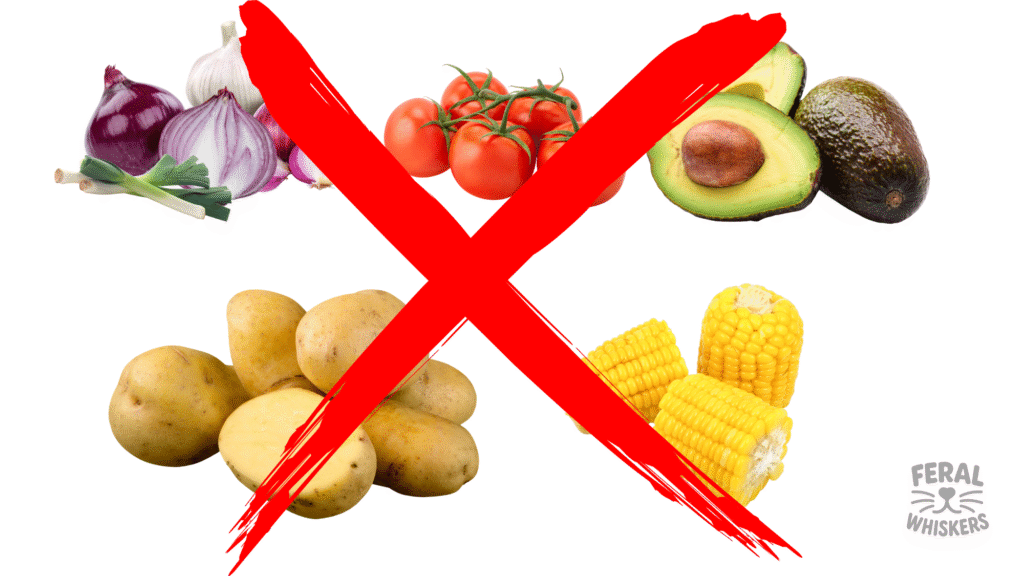📌 The Truth About Cats and Vegetables

Cats are obligate carnivores — their entire digestive system has evolved to process meat. Unlike humans or dogs, cats:
- Lack salivary amylase, the enzyme that begins breaking down carbs.
- Cannot efficiently digest plant fiber without it being pre‑processed (cooked, pureed).
- Cannot make key nutrients (e.g., vitamin A, taurine, arachidonic acid) from plant sources. They must get them from animal tissues.
👉 This means cats cannot survive on vegetables alone. But in small, carefully prepared amounts, some vegetables can still play a supportive role in their overall diet — mostly as fiber, hydration aids, or natural supplements.
✅ Safe Vegetables for Cats & Their Benefits
Here’s a list of safe veggies, with their specific uses:
- Pumpkin (cooked or 100% canned, plain):
- Famous for helping both constipation and diarrhea.
- High in soluble fiber → regulates stool.
- Rich in vitamins A, C, and potassium.
- Common holistic “go‑to” for digestive upset.
- Carrots (steamed, mashed):
- Antioxidants + beta carotene (though cats can’t convert to vitamin A, they still benefit from antioxidants).
- Provides gentle fiber, scrubs intestines, reduces mild hairball issues.
- Cats often like the mild sweetness.
- Green Beans (chopped, steamed):
- Low‑calorie, filling → perfect as a weight‑loss helper.
- Adds bulk to meals without increasing calories.
- Zucchini:
- Moisture‑rich, low calorie.
- Supports gentle hydration and digestion.
- Safe for weight‑control diets; sometimes included in prescription cat foods for obesity.
- Broccoli florets (steamed):
- Loaded with antioxidants.
- May help reduce mild inflammation in seniors.
- Some cats enjoy chewing on broccoli heads as enrichment.
- Spinach (only in moderation):
- Provides folate, iron, and vitamins.
- ⚠️ Avoid for cats with kidney/bladder issues — oxalates in spinach can worsen crystals or stones.
- Peas (steamed, mashed):
- Good source of natural fiber + tiny amount of plant protein.
- Found in many premium kibble and canned foods.
🚫 Unsafe or Toxic Vegetables for Cats

Some plant foods are outright harmful:
- ❌ Onions, garlic, leeks, shallots: Contain thiosulfates → destroy red blood cells → can cause life‑threatening anemia.
- ❌ Tomatoes (green parts, leaves/stem): Have solanine, toxic to cats.
- ❌ Avocado: Contains persin → nausea, diarrhea, toxicosis.
- ❌ Potatoes raw/green: Also contain solanine. (Small amounts of cooked plain potato are technically safe, but not useful nutritionally).
- ❌ Corn: Not toxic, but an inexpensive filler with little benefit — often overused in low‑quality cat kibble.
🌿 Holistic Roles of Vegetables in a Cat’s Diet
- Digestive Support: Pumpkin, zucchini, green beans → regulate stool, reduce constipation/hairballs.
- Hydration Boost: Water‑rich veggies like zucchini add moisture, especially for cats on kibble.
- Weight Management: Fiber‑rich veggies like green beans “bulk up” meals for overweight cats.
- Antioxidant Benefits: Veggies like broccoli, carrots, spinach → small natural boost against cellular damage.
- Natural Enrichment: Some cats enjoy the texture of veggies (broccoli florets, cooked carrot bits).
💡 In feral cats, a little plant matter is consumed naturally in the stomachs of prey like rodents or birds. Veggies in diets mimic this in a safe, controlled way.
🥦 How to Safely Feed Vegetables to Cats
Because cats cannot break down plant matter well on their own:
- Cook or Steam Veggies: Lightly cooking softens fibers and makes nutrients easier to access.
- Mash or Puree: Mash into a paste, or use a blender, so the cat’s digestive system absorbs them better.
- Serve Plain: Never add salt, butter, oils, or seasonings.
- Tiny Portions Only: Cats only tolerate very small amounts. Overfeeding causes diarrhea or gas.
Portion Tip:
- Kittens: occasional licking/taste only.
- Adult cats: ≈ ½ – 1 teaspoon of mashed veggie a few times a week is enough.
🍽️ Cat-Friendly Veggie Snack Ideas
- Constipation support: ½ tsp canned pumpkin mixed into wet food.
- Weight management topper: 1 tsp mashed zucchini and green beans added to kibble.
- Gut soother: Mashed carrot with a sprinkle of probiotic powder.
- Hydration boost: Pureed zucchini mixed with bone broth.
🩺 Veterinary Perspective
Most veterinarians agree:
- Vegetables are optional, not necessary.
- If fed, they should stay under 5–10% of the cat’s total diet.
- Adding safe veggies can help specific issues (constipation, being overweight, hairballs).
- Balance is critical: Cats must still get proteins, fats, amino acids (like taurine) from animal sources.
❓ FAQs
Q1: Can cats eat raw vegetables?
Not well. Their intestines can’t break down raw cellulose. Cook/puree for better digestion.
Q2: Are vegan or vegetarian diets safe for cats?
No. Cats cannot survive without taurine, arachidonic acid, and other nutrients found only in animal protein. Vegan diets can lead to blindness, heart failure, or death.
Q3: Can I give pumpkin every day?
Yes, in small amounts (½ tsp daily). Too much fiber may cause loose stools.
Q4: Why do so many cat foods have peas, carrots, or spinach in them?
They’re added for natural fiber, moisture, and antioxidants. But they’re minor ingredients — cats rely mainly on meat for nutrition.
💡 Final Thoughts
Vegetables should never replace protein in a cat’s diet, but when used wisely, they can be a holistic tool for better digestion, hydration, and weight management.
- 🥕 Pumpkin: for digestion.
- 🥒 Zucchini & green beans: weight & hydration support.
- 🥦 Broccoli & spinach (moderation): antioxidants.
✅ Key takeaway: Cats don’t need vegetables, but small amounts of safe, prepared veggies can complement a meat‑based diet by supporting gut health and general wellness.

